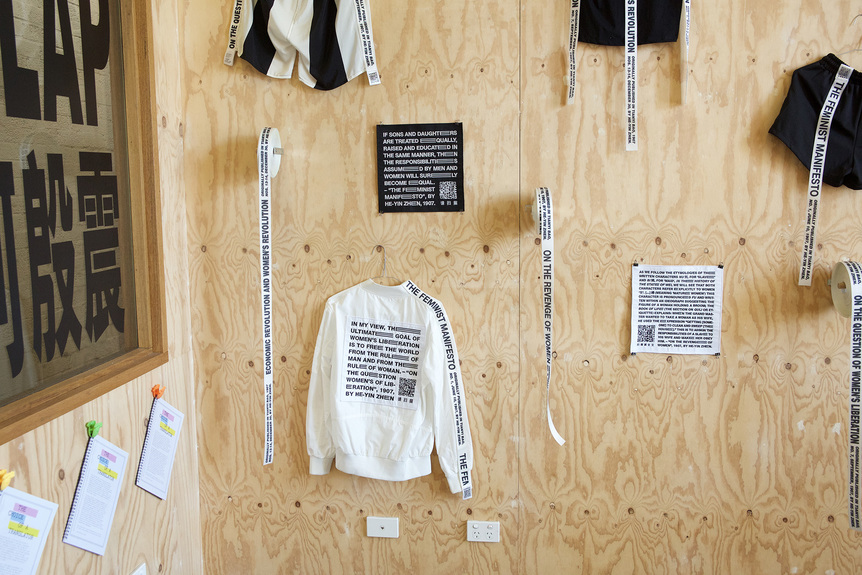
R
E
V N
E
X
T
Installation view of AMY SUO WU‘s “Thunderclap” at Artspace’s Ideas Platform, Sydney, 2019. All photos by Richard Phillips; courtesy Artspace, Sydney.
Billed as “part-shop, part-sewing workshop and part-exhibition,” “Thunderclap” saw Netherlands-based artist Amy Suo Wu set up shop in Artspace Sydney’s Ideas Platform, inviting visitors to purchase patches, ribbons and tags printed with translated excerpts from essays by Chinese feminist scholar He-Yin Zhen (1886-1920), which Wu then sewed onto visitors’ clothing. Throughout the show, Wu helped visitors choose which element to purchase and workshopped the best way to incorporate it onto a garment, before stitching it onto their clothes. This interaction between artist and audience created an uninhibited atmosphere closer to that of a market stand than exhibition.
This was the Australian iteration of a work conceived and first exhibited with similar dynamics at I: Project Space in Beijing, and brought to Sydney by Feminist South, a curatorial project by Sydney-based Kelly Doley, and Beijing-based Antonie Angerer and Anna Eschbach (of I: Project Space). Wu’s practice revives the use of steganography, a traditionally analogue activity encompassing media such as invisible ink, in order to provide an encoded visibility to ideas that have been censored, bypassing 21st-century surveillance. In this case, Wu sheds light on the work of Zhen, co-editor of anarchist journal Tianyi Bao (Natural Justice) whose writings, considered too radical, have gradually been erased from China’s historical records and were only translated into English in 2013.
Wu is a zine-maker who views steganography as an alternative channel for publishing rather than communication. By extension, fashion in her hands is “embodied publishing”—a way to publicly redistribute erased ideas. To do this, in “Thunderclap,” Wu drew from the phenomenon in which nonsensical English is used decoratively on Chinese clothing, and shanzhai (counterfeit) culture, where luxury brand logos and names are co-opted without authorization or are bastardized. In Wu’s project, fragments of text acted as a decorative foil for Zhen’s political messages, which are accessed via QR codes included alongside the words. When scanned, these codes take readers to Zhen’s Chinese-language text. In Australia, however, where the use of QR codes is far less common than in China, the effect of the work was reversed—viewers immediately understand the words, which are less of a target for censorship, and the QR codes take on an almost decorative role (most Australians are unable to read the Chinese text that they link to).
A printed zine was also displayed. Called The Choice of a Translator (2017), it contains transcripts of Wu’s artist talk at the exhibition’s initial iteration in Beijing. Infiltration of the audience by a suspected government spy caused Wu and her Mandarin translator, Zhuxin Wang, to decide to “modify, simplify and omit” some of Wu’s English content in the Mandarin translation, somewhat neutralizing the content for the ears of this (presumed to be only Mandarin-speaking) spy whilst maintaining meaning for the rest of the Mandarin-speaking audience. The resulting text contains a line-by-line comparison of Wu’s original English, and an English translation of Wang’s Mandarin version. The Choice of a Translator was a fascinating record of a live enactment of steganography in a talk about steganographic practice—an impressive meta-performance.
A connection with Wu’s mother’s dry-cleaning shop added another element to the Sydney iteration of “Thunderclap,” and a personal dimension to the political. Many businesses in Australia offering these services are operated by Chinese migrants. By working in her mother’s shop when not at Artspace, and inviting visitors to the store, Wu drew attention to and acknowledges the ongoing discipline of her mother in operating her business, and the intimacy involved in the care of other people’s clothing.
The subject of “Thunderclap” was Zhen, but the use of textiles and bodies as covert messengers, and the presentation of two sewing workshops in a fine art context (one constructed and the other a long-established business), were equally significant forms of steganography—settings for the dismantling of social structures hiding in plain sight.
Amy Suo Wu’s “Thunderclap” is on view at Artspace, Sydney, until March 10, 2019.
To read more of ArtAsiaPacific’s articles, visit our Digital Library.


















